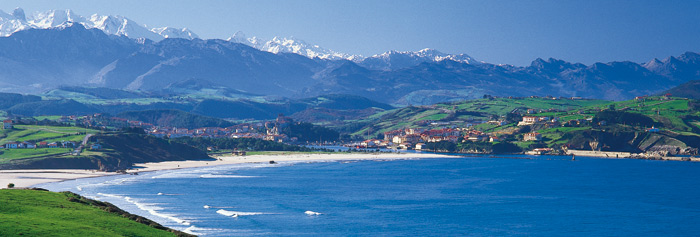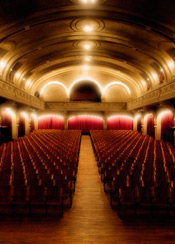Santander is a coastal city that grew in 19th century thanks to a flourishing commercial activity and also throughout the 20th century thanks to tourist activity promoted by the Spanish Royal Family. It currently offers a friendly atmosphere within a very beautiful natural setting with large beaches and attractive promenades. All these features make Santander a comfortable city to live in, with a wide range of cultural and sport attractions.
Practical information: living in Santander
Santander is a city of about 200,000 inhabitants with a privileged location by the sea and close to the mountains. Santander is an excellent place to learn Spanish because this is the only official language spoken here. Its climate is very mild and the whole region offers the varied landscape and weather features typical of this fringe of green land so different from the rest of Spain. Among its many touristic attractions, the Cantabrian cost alternates hundreds of fine white sand beaches and impressive cliffs, and the cost is a less than a 2-hour drive from the breathtaking landscapes of Picos de Europa beautiful mountains. Cantabria hosts some of the most impressive prehistoric caves in Europe, such as world-renowned Altamira. The University of Cantabria offers practical information about life in Santander in its
International Student's Guide.
The region preserves important historical remains from the Prehistoric Era, Roman ruins such as those of Julióbriga, medieval settlements, such as Santillana del Mar and several examples of the civil and religious architecture of the nineteenth and twentieth centuries. Cantabria hosts some of the most impressive prehistoric caves in Europe, such as world-renowned Altamira. The famous Guggenheim Museum is just one hour drive in neighboring Bilbao.
Santander can be reached by plane with direct flights from Madrid and Barcelona. Low-cost airlines fly from Santander into many European destinations, making it affordable to spend the weekend in London, Paris, Rome, etc. Bilbao airport, the biggest of northern Spain, is just one hour drive away.
More touristic information on Santander and Cantabria:
The region of Cantabria

The city of Santander is located in the self-governed region of Cantabria, which lies on the northern coast of Spain between Asturias and the Basque Country. Its climate is very mild and the whole region offers the varied landscape and weather features typical of this fringe of green land so different from the rest of Spain.
Cantabria is a one-province region that is an excellent place to learn Spanish because this is the only official language spoken here. It also stands out because of the great diversity of its environment. The coastal landscape of beaches, bays and cliffs blends together with valleys and highland areas, such as the mountain range of The Picos de Europa, situated in the western area. Several short but fast-flowing rivers cross the region, forming valleys perpendicular to the Bay of Biscay.
The weather in Cantabria is very mild and rainy throughout the year (the average temperature in August is approximately 19 C° and in December 9.5 C°). This humid, mild weather gives the region a rich and varied nature with plenty of woods and meadows.
The surrounding nature and the historical importance of many of its villages and buildings make this region very appealing for tourism, especially during the summer season. From the historical point of view, the region preserves important remains. Examples from the Prehistoric Era (the Altamira and Puente Viesgo Caves), Roman ruins such as those of Julióbriga, medieval settlements, such as Santillana del Mar and several examples of the civil and religious architecture of the nineteenth and twentieth centuries (The Palaces of Elsedo, Soñanes and Rañada, among others).
Leisure
Sports
Cantabria is endowed with facilities for sports, Santander, the capital, being the best equipped municipality. Football pitches and the outdoor bowling areas (a local sport) are the most widespread sports facilities throughout the region. Several yacht harbours are located along the coast, providing facilities for sailing and surfing. In the mountainous areas, mountaineering, trekking and skiing can be practised. For the important sport events, Santander has the Palacio de Festivales and the 'Racing' football ground, both of them located in the Sardinero area.

Activities for young people:
Santander municipality, through the youth office, organizes every year two cycles of activities for young people between the age of 15 and 30. The first cycle takes place from October to December and the second cycle from March to May. This leisure time programme is called 'La noche es joven' (The night is young) and covers several types of activities and creative workshops free of charge.
Further information in:
|
|
Youth office:
Oficina de la Juventud
C/ Enseñanza, 1. 39001 Santander |
 |
+34 942 211214 |
 |
+34 942 227232 |
|
E-mail: oficina_joven@mundivia.es |
Other activities, organised by the Cantabrian government, are to be found at the following Web site:
Web:
http://www.jovenmania.com
Theatres
 The city of Santander offers several cultural and leisure facilities, among which the following are the most outstanding:
The city of Santander offers several cultural and leisure facilities, among which the following are the most outstanding:
-
Palacio de Festivales (Festival Hall)
It offers a broad programme of activities throughout the year:
classical music concerts, opera, zarzuela, jazz, theatre, dance
and other performing arts.
C/ Gamazo, s/n. 39004 Santander.
 +34 942 36 16 06
+34 942 36 16 06
Web:
http://www.palaciofestivales.com
-
Centro cultural Caja Cantabria (Cultural centre)
C/ Tantín, 25. 39001 Santander.
 +34 942 20 43 00
+34 942 20 43 00
Web:
http://obrasocial.cajacantabria.com/
-
Palacio de Congresos y Exposiciones
Located at the
Sardinero area where many events take place
every year.
Museums, Libraries and other places of interest
-
Bay of Biscay Maritime Museum
C/ San Martín de Bajamar, s/n. Santander.
 +34 942 27 49 62
+34 942 27 49 62 -
Menéndez Pelayo Library and Museum
C/ Rubio, 6. Santander.
 +34 942 23 45 34
+34 942 23 45 34 -
Municipal Fine Arts Museum
The works of Spanish artists from all periods are exhibited.
C/ Rubio, 4. Santander.
 +34 942 23 94 85
+34 942 23 94 85 -
Regional Prehistoric and Archaeology Museum
One of the most important in Spain, owing to the abundant Palaeolithic remains in the region.
C/ Casimiro Sainz, 4. Santander
 +34 942 20 71 05
+34 942 20 71 05 -
Planetarium
This visit is a must for the lovers of Astronomy.
E.T.S. de Náutica. Gamazo, 1. 39004 Santander
 +34 942 20 31 00
+34 942 20 31 00
Web:
/Centros/nautica/Servicios -
Bullfighting Museum of Santander
Plaza de Toros
C/ Jerónimo Sainz de la Maza, s/n. Santander
 +34 942 34 12 04
+34 942 34 12 04 -
Museum and Research centre Altamira and Altamira caves
'The Sistine Chapel of cave painting'.
Santillana del Mar. CP: 39330. Cantabria.
 +34 942 81 80 05
+34 942 81 80 05
Web:
http://www.museodealtamira.es -
Prehistory Museum of Puente Viesgo
Cueva del Castillo (Caves)
Antigua Estación de Ferrocarril.
Puente Viesgo. CP: 39670. Cantabria.
 +34 942 59 84 71
+34 942 59 84 71
There are museums and libraries throughout the region, like the Casona de Tudanca and the Ethnological Museum in Muriedas, besides the well known ones in Santillana del Mar (Casas del Águila y La Parra, Torre de D. Borja, Palacio de Caja Cantabria, Fundación Santillana, Fundación Jesús Otero, Museum of the Inquisition), the museums of Castillo de Argüeso (XII and XIV centuries) and the roman ruins of Juliobriga (I century B.C.), the Cantabrian villages and the Picos de Europa Visitors centre.
Art galleries
Interesting webs:
Web:
http://www.santanderciudadviva.com/
Web:
http://www.guiadecantabria.com/
Nature
There are many green areas and natural parks throughout the region, some of the most important being:
- Saja Besaya Natural Park
- Cabarceno Nature Park. Penagos
- Liencres Dunes Park (Piélagos )
- Santoña and Noja salt marshes National Park
- Oyambre dunes Nature Park
- Peñacabarga Massif Park (Villaescusa)
- Picos de Europa National park (Cantabria / Asturias / Castilla-León)
- Santilla del Mar Zoo
The characteristics of Cantabrian orography together with the action of water have created impressive caves such as El Soplao Cave, an authentic natural treasure discovered because of an old mine there.
Cinemas
 Information about films showing, times and addresses can be found in any local newspaper or on internet:
Information about films showing, times and addresses can be found in any local newspaper or on internet:
- Cinesa Bahía de Santander (El Corte Inglés)
Polígono Nueva Montaña. Santander
 +34 902 33 32 31
+34 902 33 32 31
Web:
http://www.cinesa.es - Peñacastillo Cinemas (Centro comercial Carrefour)
Peñacastillo, s/n. Santander
 +34 942 34 61 81
+34 942 34 61 81
Web:
http://www.cineciudad.com - Cines Valle Real (Centro comercial Valle Real)
Alday, s/n. Cantabria
 +34 942 26 19 00
+34 942 26 19 00
Web:
http://www.circuitocoliseo.com - Film Club
Original version films are shown subtitled in Spanish, Jazz sessions etc.
C/ Bonifaz, 6. 39003 Santander
 +34 942 31 93 10
+34 942 31 93 10
Web:
http://www.palaciofestivales.com/cine.html - Groucho Cinemas
Alternative cinema and original versions.
C/ Cisneros (next to Plaza de la Esperanza)
Santander
Architectonic Monuments
Out on the town
Santander is a city well known for its pleasant and lively nightlife. Note should be made of the 'wine bar areas', where people have drinks both inside and outside the bars. The most popular are those of Cañadío and Perines at night and Peña Herbosa and Vargas at midday and, in summer, the Sardinero. There are all kinds of restaurants, including international cuisine.
There is a special city bus service ('Buscielago') available every hour at night in summer from 11:45, leaving from Plaza de Italia.
Outside Santander, other towns offer an interesting nightlife (Torrelavega, Solares, Cabezón de la Sal) also, during the summer months, many fishing villages and, in general, all the villages in the region, have a great atmosphere on the feast days of their local patron saints.
Cultural Events
The 'Paloma O’Shea International Piano Competition' (every 3 years), the 'Reina Sofía' Summer Courses and the 'International Festival of Santander' (FIS) are all held in the summer. There are events commemorating the summers of the twenties, the time when the Spanish royal family used to spend their holidays in Santander. There are art galleries offering temporary painting exhibitions and lectures on scientific and current affairs. The Winter festival takes place in Torrelavega (Santander’s neighbouring city) offering theatre, concerts... etc.
Popular celebrations
There are celebrations throughout the year, although it is in summer when most of these take place.
To get more information:
Web:
http://www.welcometospain.net/fiestas
Cost of living
The following estimates have been made taking the academic year 2014-15 as a point of reference. Hence, the following information should only be used as a guideline.
In particular, accommodation costs are estimated per winter month; in summer, prices go up and may vary significantly. Applicants are encouraged to ask for the offered assistance.
Monthly budget
Accommodation + utilities: 320 €
Maintenance costs: 230 €
Transport: 30 €
School equipment: 40 €
Extra expenses: 95 €
Total (monthly average): 710 €
Other examples
1 loaf of bread: 0.75 €
1 litre of milk: 0.95 €
1.5 litre of mineral water: 0.50 €
1 coffee at the university: 0.85 €
1 haircut women/men: 30 € / 12 €
1 newspaper: 1.10 €
1 book: 20.00 €
1 cinema ticket: 6.50 €
1 photocopy: 0.05 €
1 city bus ticket: 1.30 € / 0,66 € with bus card
